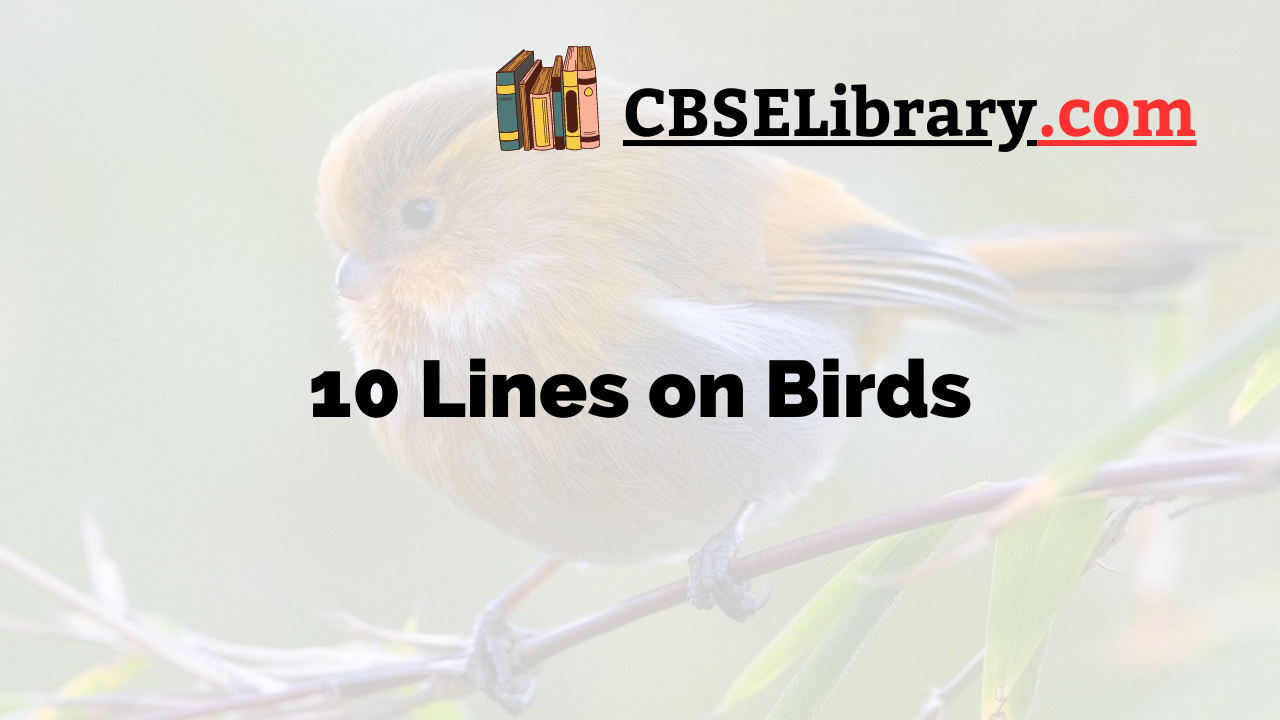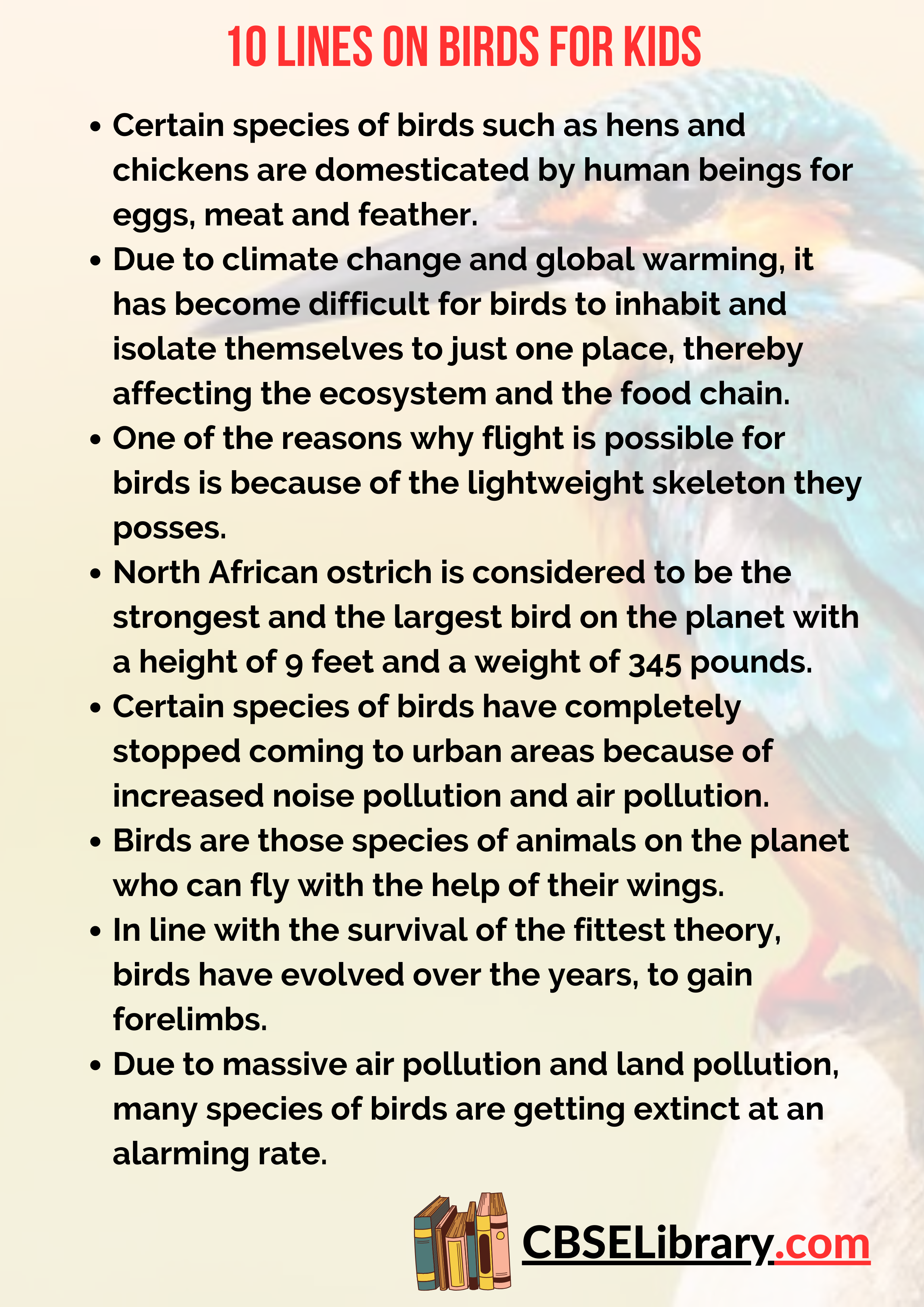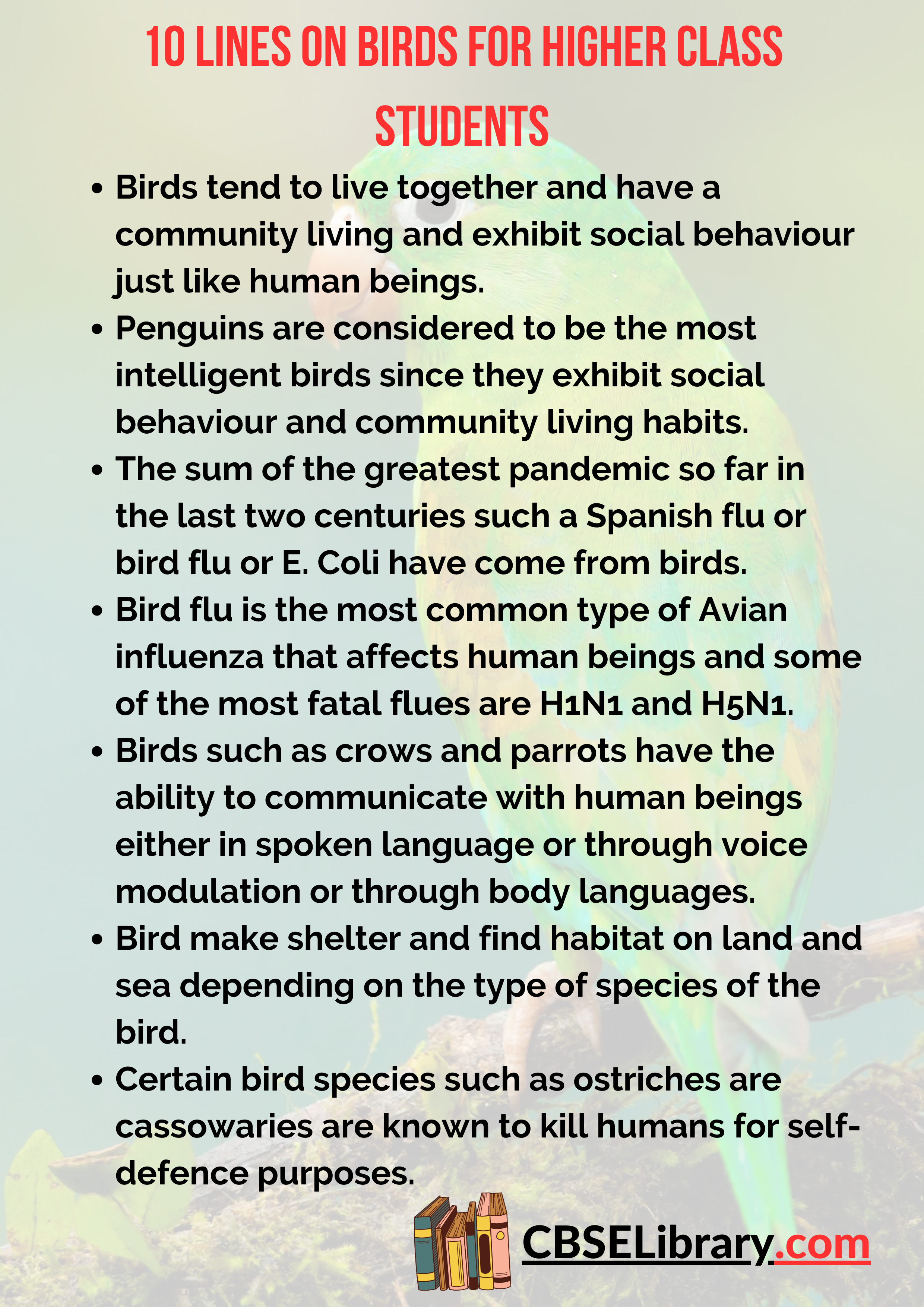10 Lines on Birds: The winged animals that can float around the sky whenever they feel like are some of the most admired animals on the planet and many of us have wished that we would be born as birds in our next birth. The flight of birds represents a sense of freedom for us human beings, who are otherwise expected to and handcuffed to be on the land.
In this 10 lines on birds, we shall be addressing many questions that one might have about birds such as how do birds fly, how many species of birds are there on the planet and how are Birds important for the ecosystem.
You can read more 10 Lines about articles, events, people, sports, technology many more.
Set 1 – 10 Lines on Birds for Kids
Set 1 is helpful for students of Classes 1, 2, 3, 4 and 5.
- Birds are those species of animals on the planet who can fly with the help of their wings.
- In line with the survival of the fittest theory, birds have evolved over the years, to gain forelimbs.
- Due to massive air pollution and land pollution, many species of birds are getting extinct at an alarming rate.
- Birds migrate from one part of the planet to other parts of the planet in search of food and shelter and these birds are known as migratory birds.
- Certain species of birds such as hens and chickens are domesticated by human beings for eggs, meat and feather.
- Due to climate change and global warming, it has become difficult for birds to inhabit and isolate themselves to just one place, thereby affecting the ecosystem and the food chain.
- One of the reasons why flight is possible for birds is because of the lightweight skeleton they posses.
- North African ostrich is considered to be the strongest and the largest bird on the planet with a height of 9 feet and a weight of 345 pounds.
- Birds have been a friend to human civilization for centuries and have helped us in many aspects of our lives. Just like how human beings pass their knowledge from one generation to another, birds also exhibit the same tendency of passing knowledge from one generation to another.
- Certain species of birds have completely stopped coming to urban areas because of increased noise pollution and air pollution.
Set 2 – 10 Lines on Birds for School Students
Set 2 is helpful for students of Classes 6, 7 and 8.
- The average lifespan of a bird is 4 years but certain species of birds such as Albatross have been known to survive for more than 42 years.
- Birds can be omnivorous, carnivorous and herbivorous depending on their species and geographical condition that they are present in.
- There are more than 10000 species of birds on the planet and scientists estimate that we haven’t discovered another 20 to 30% of the species.
- Birds are not just confined to air space but there are birds that are found underwater which are known as sea birds and water birds.
- One of the most popular birds that are domesticated around the world are chickens.
- Birds are one of those animals who build their own shelters to protect themselves and their young ones.
- It is in this nest the birds build, that they lay eggs and give rise to the next generation of their species.
- Birds are found all over the planet including the remote areas of Antarctica and the existence of birds are independent of the extreme climatic conditions.
- The respiratory system of birds is unique unlike that of human beings and they are species of a four-chambered heart.
- Certain birds are domesticated and useful for human beings while others are harmful and damage the agricultural produce and these birds are known as nuisance birds and examples of nuisance birds are crows, blackbirds and ducks.
Set 3 – 10 Lines on Birds for Higher Class Students
Set 3 is helpful for students of Classes 9, 10, 11, 12 and Competitive Exams.
- Birds such as crows and parrots have the ability to communicate with human beings either in spoken language or through voice modulation or through body languages.
- Bird make shelter and find habitat on land and sea depending on the type of species of the bird.
- Birds tend to live together and have a community living and exhibit social behaviour just like human beings.
- Penguins are considered to be the most intelligent birds since they exhibit social behaviour and community living habits.
- Birds fly from one part of the planet to another part of the planet to adapt to different climatic conditions and gather food and shelter for their metabolism.
- Scientist suggest that birds can sense any changes in the environment such as earthquakes and volcanic eruption and even weather forecast.
- The sum of the greatest pandemic so far in the last two centuries such a Spanish flu or bird flu or E. Coli have come from birds.
- Bird flu is the most common type of Avian influenza that affects human beings and some of the most fatal flues are H1N1 and H5N1.
- Ravens are some of the most intelligent birds on the planet and are found to mimic human speeches and sound. Eagles are considered as the king of birds probably because of their predatory behaviour.
- Certain bird species such as ostriches are cassowaries are known to kill humans for self-defence purposes.
FAQ’s on 10 Lines on Birds
Question 1.
How many words are there on the planet?
Answer:
it is highly difficult to predict the exact number of birds that are present on the planet but scientists have come up with a range of 300 to 400 billion birds on the planet
Question 2.
What are the 5 unique traits of a bird?
Answer:
feathers, wings, beaks, light skeleton and eggs are the five most important traits for a bird
Question 3.
From which animal did birds evolve?
Answer:
according to evolutionary theorists, birds evolved from a group of Dinosaurs called theropods
Question 4.
Which was the first bird on the planet?
Answer:
archaeopteryges are some of the earliest birds to have walked on this planet and a share certain traits with their ancestors, dinosaurs


